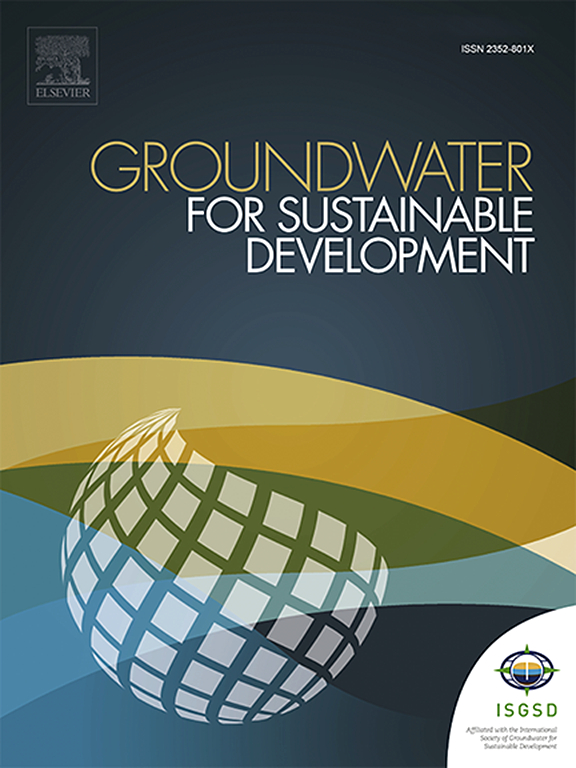Spatial and temporal distribution of arsenic in groundwater of the Brahmaputra River floodplains in Assam, India
IF 4.9
Q2 ENGINEERING, ENVIRONMENTAL
引用次数: 0
Abstract
The present study focuses on spatial and seasonal distribution of arsenic (As) along with the solute chemistry and hydrochemical evolution of groundwater in the southern bank of Brahmaputra floodplains in Assam, India. A total of 100 groundwater samples were collected from shallow aquifers (<30m) that are distributed spatially covering the entire study area during the pre-monsoon (April) and post monsoon (Nov) season in the year 2022.The samples were than analyzed for different physico chemical parameters viz; pH, EC, TDS, Ca2+, Na+, K+, Mg2+, Cl−, HCO3−, NO3−, SO42−, Fe, Mn and As to interpret the hydrochemistry and groundwater evolution in the study area. Broadly three zones were delineated based on As distribution in the region viz; zone 1 as high As zone, areas adjacent to the foothills of Naga hills,(ranged from below detection level (bdl) to 531 μg/l, mean:93.91 μg/l). Zone 2 is demarcated as low arsenic zone, near the Brahmaputra River, where As concentration was mostly <10 μg/l. Zone 3, lying between the flanks of Mikir Hills and Naga Hills is demarcated as intermediate zone where As concentration ranged from bdl to 50 μg/l. Piper plot indicates Na-HCO3 as a primary water type during pre-monsoon, while Ca-Mg-HCO3 type during post monsoon.Groundwater is undersaturated with respect to As phases such as Arsenolite and As2O5 specifying that As is in dissolved form in the groundwater. The groundwater is supersaturated with calcite (CaCO3) and Dolomite (MgCa(CO3)2and Fe(III) (Oxyhyroxide). The stable isotopes (δ18O and δ2H) of groundwater suggest that precipitation is primarily recharging the groundwater with some influence of evaporation. The results of the study will contribute to a deeper understanding of the arsenic distribution dynamics in the Brahmaputra Floodplains along with facilitating evidence-based decision making aimed at providing arsenic safe drinking water to the affected communities.

印度阿萨姆邦雅鲁藏布江漫滩地下水中砷的时空分布
本文研究了印度阿萨姆邦布拉马普特拉河冲积平原南岸地下水中砷的空间和季节分布以及溶质化学和水化学演变。在2022年季风前(4月)和季风后(11月),从覆盖整个研究区的浅层(<30m)采集了100份地下水样本。对样品进行不同理化参数的分析;pH、EC、TDS、Ca2+、Na+、K+、Mg2+、Cl−、HCO3−、NO3−、SO42−、Fe、Mn、As等水体化学和地下水演化特征。根据砷在该地区的分布,大致划分了三个区:区域1 as高as区,即靠近那迦山麓的区域,(范围从低于检测水平(bdl)到531 μg/l,平均值为93.91 μg/l)。2区为低砷区,位于雅鲁藏布江附近,砷浓度以10 μg/l居多。位于Mikir Hills和Naga Hills两翼之间的3区被划分为中间区,砷浓度范围为bdl - 50 μg/l。Piper图显示季风前主要水类型为Na-HCO3,季风后主要水类型为Ca-Mg-HCO3。地下水中砷相(如Arsenolite和As2O5)不饱和,说明地下水中砷以溶解形式存在。地下水中含有过饱和的方解石(CaCO3)和白云石(MgCa(CO3)2和铁(III)(氧)。地下水稳定同位素(δ18O和δ2H)表明降水主要是补给地下水,并有一定的蒸发影响。研究结果将有助于更深入地了解雅鲁藏布江洪泛平原的砷分布动态,并促进基于证据的决策,旨在为受影响社区提供砷安全饮用水。
本文章由计算机程序翻译,如有差异,请以英文原文为准。
求助全文
约1分钟内获得全文
求助全文
来源期刊

Groundwater for Sustainable Development
Social Sciences-Geography, Planning and Development
CiteScore
11.50
自引率
10.20%
发文量
152
期刊介绍:
Groundwater for Sustainable Development is directed to different stakeholders and professionals, including government and non-governmental organizations, international funding agencies, universities, public water institutions, public health and other public/private sector professionals, and other relevant institutions. It is aimed at professionals, academics and students in the fields of disciplines such as: groundwater and its connection to surface hydrology and environment, soil sciences, engineering, ecology, microbiology, atmospheric sciences, analytical chemistry, hydro-engineering, water technology, environmental ethics, economics, public health, policy, as well as social sciences, legal disciplines, or any other area connected with water issues. The objectives of this journal are to facilitate: • The improvement of effective and sustainable management of water resources across the globe. • The improvement of human access to groundwater resources in adequate quantity and good quality. • The meeting of the increasing demand for drinking and irrigation water needed for food security to contribute to a social and economically sound human development. • The creation of a global inter- and multidisciplinary platform and forum to improve our understanding of groundwater resources and to advocate their effective and sustainable management and protection against contamination. • Interdisciplinary information exchange and to stimulate scientific research in the fields of groundwater related sciences and social and health sciences required to achieve the United Nations Millennium Development Goals for sustainable development.
 求助内容:
求助内容: 应助结果提醒方式:
应助结果提醒方式:


